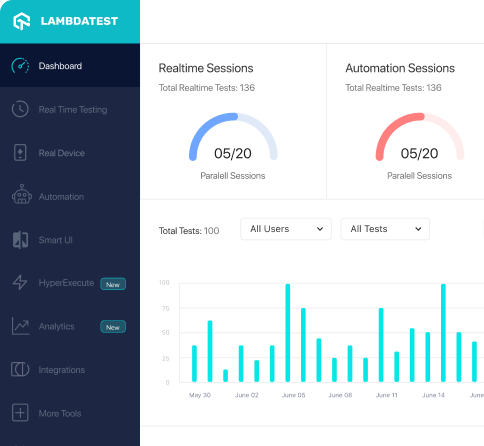How to use FailingScenarioTest class of com.tngtech.jgiven.examples package
Best JGiven code snippet using com.tngtech.jgiven.examples.FailingScenarioTest
Source:FailingScenarioTest.java
...4import com.tngtech.jgiven.tags.Issue;5import org.junit.Test;6import static org.assertj.core.api.Assertions.assertThat;7@FailingOnPurpose8public class FailingScenarioTest extends SimpleScenarioTest<FailingScenarioTest.Steps> {9 @Test10 @Issue("#234")11 public void a_scenario_with_a_multi_line_error_message() {12 given().multi_line_error_message();13 }14 public static class Steps {15 public Steps multi_line_error_message() {16 assertThat(true).as("This\nmessage\nhas\nmultiple lines").isFalse();17 return this;18 }19 }20}...FailingScenarioTest
Using AI Code Generation
1public class FailingScenarioTest extends ScenarioTest<FailingScenarioTest.FailingTestStage> {2 public void a_failing_scenario() {3 given().some_precondition();4 when().something_happens();5 then().something_should_have_happened();6 }7 public static class FailingTestStage extends Stage<FailingTestStage> {8 public FailingTestStage some_precondition() {9 return self();10 }11 public FailingTestStage something_happens() {12 return self();13 }14 public FailingTestStage something_should_have_happened() {15 throw new RuntimeException("Something went wrong");16 }17 }18}FailingScenarioTest
Using AI Code Generation
1package com.tngtech.jgiven.examples;2import com.tngtech.jgiven.Stage;3import com.tngtech.jgiven.annotation.As;4import com.tngtech.jgiven.annotation.ExpectedScenarioState;5import com.tngtech.jgiven.annotation.ProvidedScenarioState;6import com.tngtech.jgiven.annotation.Quoted;7import com.tngtech.jgiven.annotation.ScenarioState;8import com.tngtech.jgiven.annotation.ScenarioState.Resolution;9import com.tngtech.jgiven.annotation.Table;10import com.tngtech.jgiven.annotation.TableHeader;11import com.tngtech.jgiven.annotation.TableRow;12import com.tngtech.jgiven.annotation.TableRows;13import com.tngtech.jgiven.annotation.Tag;14import com.tngtech.jgiven.annotation.Tags;15import com.tngtech.jgiven.annotation.TestDescription;16import com.tngtech.jgiven.annotation.TestTag;17import com.tngtech.jgiven.annotation.TestTags;18import com.tngtech.jgiven.attachment.Attachment;19import com.tngtech.jgiven.attachment.MediaType;20import com.tngtech.jgiven.attachment.ThrowableAttachment;21import com.tngtech.jgiven.attachment.ThrowableAttachmentWriter;22import com.tngtech.jgiven.attachment.ThrowableAttachmentWriter.ThrowableAttachmentBuilder;23import com.tngtech.jgiven.attachment.ThrowableAttachmentWriter.ThrowableAttachmentBuilder.ThrowableAttachmentBuilderStep;24import com.tngtech.jgiven.attachment.ThrowableAttachmentWriter.ThrowableAttachmentBuilder.ThrowableAttachmentBuilderStep.ThrowableAttachmentBuilderStep2;25import com.tngtech.jgiven.attachment.ThrowableAttachmentWriter.ThrowableAttachmentBuilder.ThrowableAttachmentBuilderStep.ThrowableAttachmentBuilderStep2.ThrowableAttachmentBuilderStep3;26import com.tngtech.jgiven.attachment.ThrowableAttachmentWriter.ThrowableAttachmentBuilder.ThrowableAttachmentBuilderStep.ThrowableAttachmentBuilderStep2.ThrowableAttachmentBuilderStep3.ThrowableAttachmentBuilderStep4;27import com.tngtech.jgiven.attachment.ThrowableAttachmentWriter.ThrowableAttachmentBuilder.ThrowableAttachmentBuilderStep.ThrowableAttachmentBuilderStep2.ThrowableAttachmentBuilderStep3.ThrowableAttachmentBuilderStep4.ThrowableAttachmentBuilderStep5;28import com.tngtech.jgiven.attachment.ThrowableAttachmentWriter.ThrowableAttachmentBuilder.ThrowableAttachmentBuilderStep.ThrowableAttachmentBuilderStep2.ThrowableAttachmentBuilderStep3.ThrowableAttachmentBuilderStep4.ThrowableAttachmentBuilderStep5.ThrowableAttachmentBuilderStep6;29import comFailingScenarioTest
Using AI Code Generation
1FailingScenarioTest failingScenarioTest;2public void some_test_step() {3 failingScenarioTest.some_test_step();4}5public void another_test_step() {6 failingScenarioTest.another_test_step();7}8public void a_third_test_step() {9 failingScenarioTest.a_third_test_step();10}11public void a_forth_test_step() {12 failingScenarioTest.a_forth_test_step();13}14public void a_fifth_test_step() {15 failingScenarioTest.a_fifth_test_step();16}17public void a_sixth_test_step() {18 failingScenarioTest.a_sixth_test_step();19}20public void a_seventh_test_step() {21 failingScenarioTest.a_seventh_test_step();22}23public void an_eighth_test_step() {24 failingScenarioTest.an_eighth_test_step();25}26public void a_ninth_test_step() {27 failingScenarioTest.a_ninth_test_step();28}29public void a_tenth_test_step() {30 failingScenarioTest.a_tenth_test_step();31}32public void a_eleventh_test_step() {33 failingScenarioTest.a_eleventh_test_step();34}35public void a_twelfth_test_step() {36 failingScenarioTest.a_twelfth_test_step();37}38public void a_thirteenth_test_step() {39 failingScenarioTest.a_thirteenth_test_step();40}41public void a_fourteenth_test_step() {42 failingScenarioTest.a_fourteenth_test_step();43}44public void a_fifteenth_test_step() {45 failingScenarioTest.a_fifteenth_test_step();46}47public void a_sixteenth_test_step() {48 failingScenarioTest.a_sixteenth_test_step();49}50public void a_seventeenth_test_step() {51 failingScenarioTest.a_seventeenth_test_step();52}53public void an_eighteenth_test_step() {54 failingScenarioTest.an_eighteenth_test_step();55}56public void a_nineteenth_test_step() {57 failingScenarioTest.a_nineteenth_test_step();58}59public void a_twentieth_test_step() {60 failingScenarioTest.a_twentieth_test_step();61}62public void a_twenty_first_test_step() {FailingScenarioTest
Using AI Code Generation
1FailingScenarioTest failingScenarioTest;2public void test() {3 .given().some_state()4 .when().some_action()5 .then().some_outcome();6}7public void test2() {8 .given().some_state()9 .when().some_action()10 .then().some_outcome();11}12 at com.tngtech.jgiven.impl.ScenarioExecutor.executeStage(ScenarioExecutor.java:70)13 at com.tngtech.jgiven.impl.ScenarioExecutor.executeStage(ScenarioExecutor.java:28)14 at com.tngtech.jgiven.impl.Scenario.executeStage(Scenario.java:96)15 at com.tngtech.jgiven.impl.Scenario.executeStage(Scenario.java:14)16 at com.tngtech.jgiven.examples.FailingScenarioTest$2.then_some_outcome(FailingScenarioTest.java:33)17 at sun.reflect.NativeMethodAccessorImpl.invoke0(Native Method)18 at sun.reflect.NativeMethodAccessorImpl.invoke(NativeMethodAccessorImpl.java:62)19 at sun.reflect.DelegatingMethodAccessorImpl.invoke(DelegatingMethodAccessorImpl.java:43)20 at java.lang.reflect.Method.invoke(Method.java:497)21 at org.junit.runners.model.FrameworkMethod$1.runReflectiveCall(FrameworkMethod.java:50)22 at org.junit.internal.runners.model.ReflectiveCallable.run(ReflectiveCallable.java:12)23 at org.junit.runners.model.FrameworkMethod.invokeExplosively(FrameworkMethod.java:47)24 at org.junit.internal.runners.statements.InvokeMethod.evaluate(InvokeMethod.java:17)25 at com.tngtech.jgiven.junit.ScenarioTestRule$1.evaluate(ScenarioTestRule.java:49)26 at org.junit.rules.RunRules.evaluate(RunRules.java:20)27 at org.junit.runners.ParentRunner.runLeaf(ParentRunner.java:325)28 at org.junit.runners.BlockJUnit4ClassRunner.runChild(BlockJUnit4ClassRunner.java:78)29 at org.junit.runners.BlockJUnit4ClassRunner.runChild(BlockJUnit4ClassRunner.java:57)30 at org.junit.runners.ParentRunner$3.run(ParentRunner.java:290)31 at org.junit.runners.ParentRunner$1.schedule(ParentRunner.java:71FailingScenarioTest
Using AI Code Generation
1package com.tngtech.jgiven.examples;2import com.tngtech.jgiven.junit.ScenarioTest;3import org.junit.Test;4public class FailingScenarioTest extends ScenarioTest<FailingScenarioTest.GivenTestStage, FailingScenarioTest.WhenTestStage, FailingScenarioTest.ThenTestStage> {5 public void a_failing_scenario() {6 given().a_precondition();7 when().something_happens();8 then().something_should_happen();9 }10 public static class GivenTestStage extends GivenTestStage {11 }12 public static class WhenTestStage extends WhenTestStage {13 }14 public static class ThenTestStage extends ThenTestStage {15 }16}17class FailingScenarioTest extends ScenarioTest<GivenTestStage, WhenTestStage, ThenTestStage> {18 GivenTestStage given() {19 return startStage(GivenTestStage.class);20 }21 WhenTestStage when() {22 return startStage(WhenTestStage.class);23 }24 ThenTestStage then() {25 return startStage(ThenTestStage.class);26 }27}FailingScenarioTest
Using AI Code Generation
1package com.tngtech.jgiven.examples;2import static com.tngtech.jgiven.report.model.GivenStage.*;3import org.junit.Test;4import com.tngtech.jgiven.Stage;5import com.tngtech.jgiven.annotation.ScenarioStage;6import com.tngtech.jgiven.junit.ScenarioTest;7import com.tngtech.jgiven.report.model.GivenStage;8public class FailingScenarioTest extends ScenarioTest<GivenStage, WhenStage, ThenStage> {9 WhenStage when;10 ThenStage then;11 public void a_failing_scenario() throws Exception {12 given().some_state();13 when().something_happens();14 then().something_should_have_happened();15 }16 public static class WhenStage extends Stage<WhenStage> {17 public WhenStage something_happens() {18 return self();19 }20 }21 public static class ThenStage extends Stage<ThenStage> {22 public ThenStage something_should_have_happened() {23 return self();24 }25 }26}27public class WhenStage extends Stage<WhenStage> {28 @As("something happens")29 public WhenStage something_happens() {30 return self();31 }32}33This is a very simple example. In real life, you will have more complex tests, with more steps and more stages. This is why it is important to alwaysAutomation Testing Tutorials
Learn to execute automation testing from scratch with LambdaTest Learning Hub. Right from setting up the prerequisites to run your first automation test, to following best practices and diving deeper into advanced test scenarios. LambdaTest Learning Hubs compile a list of step-by-step guides to help you be proficient with different test automation frameworks i.e. Selenium, Cypress, TestNG etc.
LambdaTest Learning Hubs:
- JUnit Tutorial
- TestNG Tutorial
- Webdriver Tutorial
- WebDriverIO Tutorial
- Protractor Tutorial
- Selenium 4 Tutorial
- Jenkins Tutorial
- NUnit Tutorial
- Jest Tutorial
- Playwright Tutorial
- Cypress Tutorial
- PyTest Tutorial
YouTube
You could also refer to video tutorials over LambdaTest YouTube channel to get step by step demonstration from industry experts.
Most used methods in FailingScenarioTest
Try LambdaTest Now !!
Get 100 minutes of automation test minutes FREE!!



